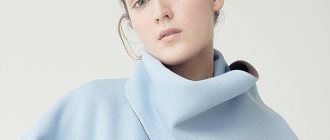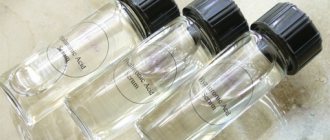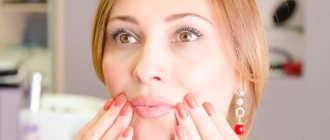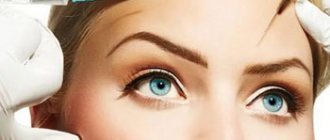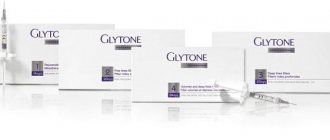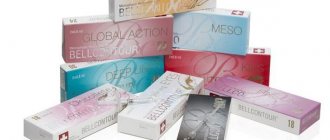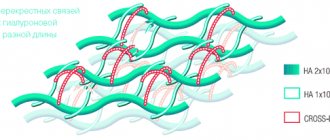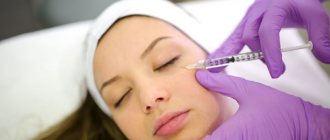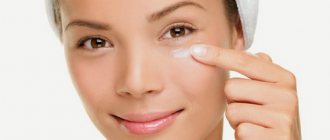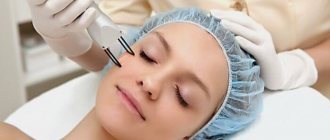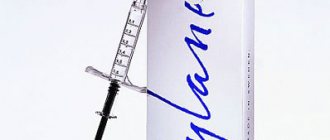Nappage technique
(superficial mesotherapy, “bedspread”, “picottage”)
This technique is a series of frequent injections. The approximate volume of the drug administered in each injection is 0.02 ml. Depending on the depth of drug administration, superficial, medium and deep nappage are distinguished.
Superficial nappage
Superficial nappage – administration of drugs to the epidermal level, depth no more than 0.5 mm. For this technique, it is more convenient to use short mesotherapy needles (4 mm). The needle is held with the cut side up.
The tilt of the needle does not matter and can be 30-90 degrees. The drug is injected to a depth of no more than 0.5 mm, at 1/3 - 2/3 of the needle cut. The distance between injections should be no more than 0.5 -1 cm.
This technique is used to treat the area of the face, neck and décolleté along massage lines. If the superficial massage is performed correctly, there should be no “blood dew”, since the injections do not reach the papillary dermis.
Superficial nappage is used to introduce any cocktails with the exception of preparations with a gel consistency.
It is not advisable to use expensive cocktails with this injection technique, since the bulk of the drugs remain on the skin due to the shallow injection depth. Part of the drug is then absorbed, but with nappage the loss of the drug is up to 50%.
Dry nappage. It is possible to carry out surface nappage without using a cocktail - the so-called “dry nappage”.
Medium nappage
Medium nappage. Injections are performed at the level of the dermis, at the depth of the papillary or reticular layer. This technique is used mainly in the treatment of vascular diseases of the face and body, as it allows the delivery of medicinal substances directly to the choroid plexuses of the dermis.
When working with the face, the angle of the needle is 45 degrees, the insertion depth is 1-1.5 mm, the distance between injections is 1-2 cm. The needle is held with the cut facing upward.
Injections are carried out along the vascular pattern or along massage lines. It is possible that droplets of blood may be released at the site of some injections on the surface of the skin and the formation of microhematomas, as damage to the walls of blood vessels occurs.
Deep nappage
Deep attack, deep mesotherapy. This technique is also called “infiltration”. Deep nappage is used only in mesotherapy treatment of the body for the purpose of correcting local fat deposits and in the treatment of cellulite.
The depth of administration of cocktails should be at least 10 mm, since the drug must be delivered to the subcutaneous fatty tissue. To perform deep nappage, needles 13 mm long are used. The needle angle is 90 degrees.
Using deep nappage, mainly lipolytic drugs are administered.
Their varieties
Micropapular and papular
This method is used to introduce fillers in different areas of the face (forehead, cheekbones, cheeks, lower jaw), in the neck, décolleté, and hands. The filler is injected into the skin using a needle, which is positioned at an angle of 45°. A papule forms at the injection site, which subsequently resolves (within 1 to 4 days).
Using this technology, Gialuform, Gialripayer, NCTF135, Beutel are administered.
How to lift the corners of your lips with filler (photo)
Point by point method
This method simulates linear injection, since the injections are administered pointwise, but without gaps. Place them on the fold or wrinkle line. The drug is administered in small portions at certain points.
The method is ideal for particularly sensitive areas: periorbital (eye area), perioral (mouth area), neck area. This is how Stylage is introduced.
Linear-retrograde
The purpose of this method is to strengthen a specific area. More often it is used to strengthen various facial areas (for example, nasolabial folds) and décolleté. The fillers are introduced either parallel to the dermis or intradermally. Injection is carried out at the moment the needle “emerges” from the skin, which is inserted at an angle of 45°. The filler seems to “raise” the bottom of the wrinkle. This is the simplest technique for introducing fillers.
Drugs such as Perfecta, Etermis 2, Revi Brilliants are administered intradermally. Aquashine is injected using a linear technique.
Fan
The “fan” technique is carried out on the principle of a linear technique, but all the lines diverge from one point, forming something like a fan, which is why the method got its name. From 2 to 4 ray lines are performed. When performing them, the needle is not removed, but is turned at an acute angle. This method is used to inject fillers into the nasolabial folds and corners of the lips. It can also be used for lip augmentation.
Using this technique, Regeness and Amaline Soft are administered.
Orchid
This technology is used to inject fillers into large nasolabial folds. They use the “fan” principle. The difference is that when performing the “orchid” technique, the “fan” is performed repeatedly, along the entire length of the wrinkle.
Net
To carry it out, the principle of linear technology is used. Injections are performed along lines located at a distance of 2 - 3 mm from each other, crossed by the next row at a right angle, which forms a kind of mesh. The method allows you to increase tone in the lips, cheeks and nasolabial folds.
This method is suitable when using Amaline Soft.
Filler injection areas
Multipuncture
The procedure consists of a numerous number of points that form a single line. For injection, needles are used that are inserted at an acute angle. The method is effective in areas of increased relief (between the eyebrows and the bridge of the nose). This technique is also used in cases where it is necessary to stimulate wrinkles. When using multipuncture technique, the concentration of hyaluronic acid and the depth of injection are very important.
Parisian
It is used to correct lip contour and facial wrinkles. In this case, a linear-retrograde method is used with further fixation of the red border of the lips using “columns”.
Hollywood
It is based on the linear-retrograde technique, which is complemented by bolus and linear-volume techniques. Used for thorough lip correction and the formation of a “Cupid’s arch”.
This video demonstrates the bolus technique:
Fern
The technology is used to correct deep wrinkles. The essence of the method: based on the linear-retrograde technique, unidirectional injections are made at a distance of 2 - 3 mm from each other. Then, between previous injections, injections are made that have the opposite direction.
"Mona Lisa"
This technique is used to lift commissures (corners of the lips) and model the zygomatic area. The drug is administered through two punctures made in the upper part of the lip, directly into the contour of the red border. For administration, a linear-retrograde technique is used. The drug is administered in a small volume (0.05 mm). To model the cheekbones, a volume bolus technique is used, in which a large amount of the drug is injected very slowly.
Technique for introducing filler into the tear trough
Sandwich technique
In this case, the method of layer-by-layer injection of fillers is used. Each layer has its own density, which allows you to get a three-dimensional lifting effect. To carry out the technique, a micropixel cannula is often used. The technique is used to correct the periorbital zone.
This technique is used when administering Macroline, Belotero, Surgiderm.
Development and promotion of mesotherapy and biorevitalization techniques
To begin with, it would be nice to determine and accept as truth by the entire professional community how we evaluate the method of action on the skin in this case - by the method of administration or by the pharmacological properties and planned results of the drug that is administered. This would save doctors and nurses from many misunderstandings and allow them to study both together. After all, no one will argue with the fact that knowing at the same time HOW and WHAT to enter is natural professional knowledge!
Next, you need to come to the understanding that all the drugs in the group still need to be combined under one (and no matter what) name. And this will protect medical workers from a lot of misunderstandings. Which ones? Let's imagine that they ask you what you do here in your clinic? If you answer according to the Nomenclature of Medical Services:
| A11.01.010 | Injection of drugs into the skin lesion. |
But, unfortunately, mesopreparations and biorevitalizants are not registered as medicines. The only exception I know of are homeopathic medicines from Heel.
If we answer, taking into account the Procedure for providing assistance in cosmetology, then we can say that we are engaged in mesotherapy and biorevitalization. Then bioreparation, redermalization, biorestructuring and others are left behind.
There is a third way - to refer to a medical technology registered by Roszdravnadzor - then you can use the concept of mesotherapy and, with some stretch, bioreparation, because the drugs for it are registered within the framework of the medical technology "Contour correction of involutional changes in facial skin with biodegradable preparations based on biotechnological hyaluronic acid" Perfectha Derm", "Hyaluform", "Hyalripayer".
Liquid mesothreads: what is it?
Liquid mesothreads are the latest achievement and the result of scientists’ work on the problem of facelift. When lifting using this method, threads are not used, but an action similar to their use determines the name.
Liquid monofilaments consist of hyaluronic acid and zinc chloride, forming a degradable bio-gel. Getting into the dermis, it fills biological voids in it, causing a protective reaction of the body. Reacting, the skin forms a sealing tissue around the gel particles, causing skin compression and a lifting effect.
The introduction occurs through cannulas using a syringe. The volume of solution per point ranges from 0.1 to 0.2 ml, but not more than 3 ml per zone. The following areas can be corrected with this gel:
- face oval;
- forehead;
- nasolabial fold;
- eyes;
- lips;
- neck and décolleté;
- hips, shoulders and stomach.
The method is effective for eliminating loss of elasticity, tone and dehydration of the skin. The level of bio-gel introduction extends to the middle and deep layers of the dermis.
Technique for introducing mesothreads
The procedure is carried out using disposable guide needles strictly according to the implantation plan outlined by the cosmetologist at the preliminary consultation. The plan is determined based on the characteristics of the skin, the degree of age-related changes, the depth of wrinkles and the condition of the skin.
The needle is inserted under the skin to a certain depth, and after securing the thread, it is removed. Mesothread, remaining in the thickness of the dermis, provokes a lifting effect, tightening and smoothing out wrinkles. The result is observed instantly, the enhancement of the effect and the final version of the lift are assessed after 2 months.
The thread lifting effect lasts for 2-5 years.
Who is suitable for mesotherapy?
Although the relevance of skin care has grown over the years, it would be a mistake to say that the main indication for mesotherapy is age. Problems of an aesthetic and medical nature can haunt both a very young person and a mature one.
Metosotherapy injections help with diseases and conditions such as:
- acne and post-acne;
- lethargy, dryness, unhealthy skin color;
- loss of clarity of facial contours;
- scars and cicatrices;
- pigmentation disorders;
- consequences of sunburn;
- wrinkles, ptosis and other age-related skin changes;
- dark circles under the eyes;
- dryness, dullness, fragility, hair loss;
- local fat deposits, etc.
Of course, there are those for whom mesotherapy is not suitable.
The procedure is contraindicated in the following cases:
- individual allergic reactions to the components of meso-cocktails;
- skin and other diseases in the acute stage;
- tendency to form keloid scars;
- diseases of the circulatory system;
- pregnancy, lactation;
- oncological diseases.
Facial mesotherapy. Video
A common drug in the mesotherapy procedure is hyaluronic acid, which helps to moisturize skin cells and produce enzymes in the body that are responsible for the firmness, velvety and elasticity of the skin. Together with this component, various vitamin complexes, various antioxidants, stimulants of natural origin, as well as plant extracts that have healing properties for rejuvenating the body are used.
Types of mesotherapy for the face
Types of procedures depending on the constituent components:
- • Fractional, simultaneous exposure of several needles to one area of the body. It is performed with a special device - a dermoroller, with which a dosed amount of fortified liquid is injected through the skin.
- • Non-injection, no painful injections. The drug is applied directly to the skin, creating a balanced “cocktail” that passes through the pores into the subcutaneous layer. Its action is enhanced by laser radiation or magnetic waves. Ion or cryogenic devices are also used.
Contraindications for facial mesotherapy
Contraindications for facial mesotherapy may include the following:
- • possible complications, skin decay, bruises, cracks, swelling, tumors, itching;
- • if the body is dependent on the mixture for the procedure, the result will be minimal;
- • it is strictly forbidden for pregnant women, children under 16 years of age, and women over 55 to use this method;
- • for fungal skin diseases;
- • diabetes mellitus.
Almost every session leaves bruises after facial mesotherapy, but they pass quickly and do not leave marks on the skin. The procedure is really painful, it is best to use non-injection therapy, it is even indicated for lactation and minor superficial aesthetic problems of the dermis.
What components are included in the healing “cocktail” of mesotherapy?
First of all, it is hyaluronic acid, which smoothes wrinkles, removes acne, opens and cleanses pores, and is responsible for normalizing the sebaceous glands. Vitamins B (prevent the appearance of allergic rashes), C (anti-aging skin), A (protective barrier against stress). Organic silicon, a peptide responsible for skin restoration at the cellular level. Carnitine also accelerates the burning of fat cells.
This procedure will be necessary for age-related skin aging, face lifting, in the fight against cellulite, increased pigmentation and rosacea.
How to prepare for the procedure
“If you are told that the technique is absolutely safe and can be performed even now, do not rush to do mesotherapy in this particular clinic.” A specialist who respects himself and the client must play it safe and take certain measures.
- The patient must consult a doctor about possible contraindications and become familiar with all the nuances of the procedure.
- The doctor must decide what components are needed for the future session, and also create a schedule for visiting the patient with a clearly defined number of necessary procedures.
Attention: a week before therapy, you should avoid visiting the solarium, prolonged exposure to the sun, and consuming medications and alcoholic beverages.
What does facial mesotherapy guarantee?
The positive aspects of the technique include increasing skin tone in a short time, eliminating wrinkles and bags under the eyes, personal selection of components for each session and instant long-term results.
Basics of facial mesotherapy technique with hyaluronic acid
First, the doctor performs a skin analysis and determines the mixture for the procedure. After cleansing the face with toner (makeup removal is carried out in advance), a nourishing mask is applied for 10 minutes. This composition has a wonderful effect on acne-prone dermis. After the allotted time has passed, the patient washes and dries the skin with a towel. Now an injection is made to a depth of up to 4 mm; the entire outcome of the session depends on the correct administration of the cocktail.
To consolidate the result, the clinic is obliged to offer the patient a massage based on medicinal clay and apply hyaluronic serum to the facial skin, which will help relieve swelling and prevent the appearance of bruises after facial mesotherapy.
It is very difficult to do such a procedure at home, because it will require considerable experience in administering the injection, as well as special training in the basics of fractional facial mesotherapy techniques.
Non-injection mesotherapy at home
Such sessions are more common and are suitable for people without professional knowledge and skills, but in any case it is necessary to consult a specialist and strictly follow the advice of experienced professionals.
Stages of facial mesotherapy at home:
- • the face is cleaned with a non-abrasive scrub, after which a certain composition is applied, and after a few minutes the facial area is massaged with a professional preparation;
- • after 10 minutes, the mixture is washed off with warm water, and a proven nourishing cream is applied to the face.
A total of 10 procedures must be done, one per week; after six months, sessions can be repeated.
User reviews about facial mesotherapy
Of course, there are different opinions regarding this therapy. Reviews about facial mesotherapy are as follows:
“I had needleless electroporation done in the salon for my birthday. The effect is quite acceptable, no consequences were observed. The cosmetologist did not let me go after the procedure for about 40 minutes, treating every unevenness on my face. I was satisfied!”
“My review of needle-free facial mesotherapy is positive. After the third session, my wrinkles decreased, my face became fresher and bright pigment spots disappeared. After completing all the procedures, the doctor left me with a lot of tips that will help get rid of dehydration and dullness of the face. I have been using them for several years and thank the specialist for the respectful attitude he has shown to me!”
“I would like to write a review about hardware facial mesotherapy. I will say right away that it was very painful, and the consequences were not the most pleasant, but the result still showed the positive aspects of the procedure: the face cleared up, became brighter, the contours were outlined, and blood circulation was normalized. I attend these sessions regularly and am proud of my appearance!”
Mesotherapy is an opportunity to regain youth and beauty. The procedure is effective, but only professionals can guarantee the best results.
Drip technique in the correction of nasolabial folds
Depression of the nasolabial folds remains one of the most common complaints of our patients. But behind all the apparent simplicity of the injection, this area remains one of the most complex and treacherous! Let's look at another correction method in this area.
Problem
The largest number of cases of vascular complications are described specifically during the correction of nasolabial folds, since this is the area where large vessels are located - a., v. fasialis - and lack of collateral blood supply. The facial artery supplies a significant area, which is why the most extensive necrosis, covering not only this area, but also extending to the wing and tip of the nose, is described precisely when working with the nasolabial folds. The facial artery has a tortuous structure, it runs along the nasolabial fold, the facial vein is more straightforward and runs somewhat laterally. Yang, Hun-Mu et al. described several variations in the location of the facial artery, and in 42.9% it runs along the nasolabial fold, which causes a high risk of vascular complications when working in this area [Fig. 1]. At the base of the wing of the nose, the facial artery passes through the superficial fatty tissue; in other areas, it passes through the deep layer of fatty tissue between the facial muscles. That is why one of the important safety criteria is the depth of injection of hyaluronic acid when correcting nasolabial folds. No less important is the technique of introducing filler based on hyaluronic acid. The most popular techniques in this area are linear retrograde and bolus. Vessel embolism (filler entry partially or along the length of the needle into the lumen of the vessel) is possible when using the linear-retrograde technique. And compression of the vessel with the drug is easy using the bolus technique (injection of a large volume of gel into the local area). The choice of drug is another important nuance in the prevention of vascular complications in the area of the nasolabial folds. Some fillers significantly increase in volume due to their hydrophilicity - attracting and retaining additional amounts of water. In areas of increased risk of vascular complications, your choice should be on drugs that have residual low hygroscopicity. From the above we can conclude: a reasonable choice of filler, its introduction in a small volume, adherence to the injection technique taking into account dangerous anatomical zones allow the procedure for correcting nasolabial folds to be carried out safely and effectively.
Choice of drug
Fillers from the Yvoire line have proven themselves well in this “dangerous” zone. Firstly, a high degree of dynamic firmness and elasticity guarantees the maintenance of volume even with micro-dosed injection of the gel. Secondly, high cohesiveness avoids displacement and fragmentation of the drug from the injection zone in patients with a muscular type of structure. Thirdly, the Yvoire line of drugs are characterized by minimal residual hygroscopicity, which, in turn, does not provide additional volume due to swelling after the procedure, which is very important for working in an area with an increased risk of compression-ischemic syndrome. Fourthly, the sufficient plasticity of these drugs facilitates their modeling in tissues, after which neither the patient nor the doctor feels the injected gel upon palpation.
Author's microdroplet injection technique
Before the procedure, topical anesthesia is administered with Emla for 20 minutes. The choice of instrument was a 27G 13 mm needle, since it is impossible to implement the microdroplet technique through the cannula and it is not possible to inject the drug perpendicular to the skin surface. I would like to draw your attention to the fact that the introduction of filler into the deep layers of subcutaneous fat using the microdroplet technique is quite safe. The first injection point is located in the nasolabial fold itself, with a deviation from the wing of the nose at a distance equal to the length of the needle (13 mm). The puncture is made perpendicular to the surface of the skin into the deep layers of subcutaneous fat, then the needle is turned at an angle of 45 and slowly moves medially upward to the wing of the nose, retreating 2 mm from the nasolabial fold. It is necessary to retreat so that the drug does not enter laterally during injection, which can lead to overhanging nasolabial fat and worsening of the nasolabial fold. At this level, the first drop of the drug is administered, then retrograde drip administration is repeated along a given vector [Fig. 2]. After the drug has been injected by retrograde drip, the needle is not removed from the skin, but is moved more medially in a fan-like manner (fan technique) and the drug is injected retrograde by drip along the adjacent vector [Fig. 3]. The drug is administered in a similar manner along the third specified vector [Fig. 4]. In this way, the deepest part of the base of the nasolabial fold is filled. Next, we retreat from the first injection point a distance approximately equal to the length of the needle (13 mm) and make a second puncture, inserting the needle perpendicular to the surface. We again reach the deep fatty tissue, turn the needle 45 degrees, move it medially upward to the first inlet and inject the drug by retrograde drip [Fig. 5]. After which the needle is again not removed from the skin, but moves fan-shaped to fill the more medial vector in a retrograde manner [Fig. 6]. Next, we retreat from the second injection point to a distance approximately equal to the length of the needle (13 mm) and make a third puncture, introducing the drug using a fan-shaped technique using a retrograde drip [Fig. 7, 8]. The final touch is the “underwing” final injection, in which the most pronounced area of depression of the nasolabial folds in the area of the wing of the nose is most effectively corrected. A puncture is made perpendicular to the skin level from the very nasolabial fold at its base, but the needle “dives” deep under the wing of the nose for the entire length, after which the gel is slowly linearly retrogradely injected in a volume of 0.1–0.15 ml once [Fig. 9]. The “subala” injection effectively lifts the base of the nose and eliminates the most pronounced area of depression at the base of the nasolabial fold, especially in patients with a muscular and deformational type of structure. A complete scheme for correction of the nasolabial fold is presented in Figure 10.
The result of injection correction
The result of the injection correction is presented in Figure 11. The Yvoire Volume drug was consumed in a total volume of 1.0 ml (0.5 ml on each side). Contour plastic surgery with this drug provides a long-lasting, pronounced natural result.
Source: https://www.yvoire.ru
